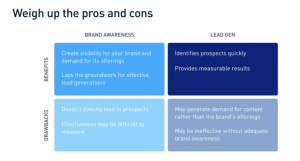How Branding Executives Can Rise to the Challenge in 2022
BY: ANTONIO BUCHANAN & PARIS BUCHANAN | FEB 2, 2022 – 6 MIN READ

How Branding Executives Can Rise to the Challenge in 2022
BY: ANTONIO BUCHANAN & PARIS BUCHANAN | FEB 2, 2022 – 6 MIN READ

A month into the New Year, we already see a lot going on in 2022. From changes in data privacy to how the Metaverse could affect brands, plus the continued effects of the pandemic and more on businesses and consumers, branding challenges never end. A&P co-CEOs Antonio Patric Buchanan and Paris Buchanan have compiled their thoughts on the branding challenges relevant to CMOs, CEOs, and other executives today.
Lead Generation v. Branding
Do not confuse lead gen for branding. Insights and conversion data are important touchpoints for brands to know how their marketing performs, but they aren’t everything and the ease of a lead gen platform should never trump good branding. The two tools should work symbiotically as part of a brand strategy. Research conducted by LinkedIn B2B Institute shows that there is efficiency in marketing when 46 percent of marketing budgeting is allocated to brand awareness and 54 percent to lead generation—about half and half, although we lean more heavily toward having great branding that will build your foundation. Once that is built and standing strong, then it’s time to bring in a lead gen strategy that aligns with what you’ve already established. Branding can generate leads, but lead gen must support your branding.
Branding for Humans, Not Data
Data points are extremely important, but so is your instinct. Our whole brand at A&P is built on the ethos of creating human connection through branding. “Igniting the love affair between brands and consumers” means knowing those consumers in more personal, individualized ways than just the data you can glean from a contact form on a website.
In a Salesforce story examining leading business executives around the globe and their take on data versus instinct, the lean toward the latter is abundantly clear. “Oprah Winfrey once said mistakes happen when she doesn’t listen to that ‘still, small voice’ within her. Richard Branson, who became the first (but amazingly not the only) billionaire to venture into space, has admitted to relying more on gut instinct than research and statistics.
“Data versus intuition is a false choice. You need both,” said Wilfried Schobeiri, chief technology officer at Banyan, a New Jersey–based data marketplace. “The best decisions tend to be those where data supports or enables instinct and intuition to come into play—and are then followed up to measure the impact and success of that decision.”
TL;DR—research is important, but actually living with your target is better. Trust human instincts, desires, and communication over straight data any day. How else will you know what your audience really needs?
Read More about the Future of Qualitative Consumer Research.
Go Big or Don’t Bother
When it comes to your brand’s looks and new content creation, the urge to play it safe might seem like a good business strategy. But if that’s what you’re thinking, why bother changing anything at all? Design and content should be meant to elicit an extreme response. Playing it safe, staying in the middle, is a waste of time and money. Consumers respond to change and they might notice a safe option, but it’s the bold, big ones that they’ll be talking to their friends about.
Major beauty brand Dove was founded in 1957, but when it started losing sales in the late-1990s and early 2000s to competitors, its leaders knew it was time for a major overhaul. The “Real Beauty” campaign was born in 2004, marketing to women of all shapes, sizes, ages, and skin tones. It was the first brand of its industry to blatantly take such a “radical” approach of showing such diversity in its branding. “It’s pretty refreshing to see people who look like you and me modeling for a major beauty brand,” says QLB Blog. “Dove paved the way for advertising with women who aren’t career models and the positive response encouraged other competitors to follow suit like American Eagle, Forever Yours Lingerie, and Elle magazine. The campaign also resulted in over 1.5 million visitors to the Campaign for Real Beauty website.”
Recently, our team launched a brand-new digital content platform for a traditionally brick and mortar institution—a highly revered science and technology museum. The Franklin Institute in Philadelphia has faced significant challenges since the beginning of COVID-19 and even before, as consumers crave more digital content and different ways to interact with the museum. Its members can now log on 24/7 to experience The Franklin Institute’s content on Beyond, including new podcast and video series focusing on exciting topics in science. Providing a new way for consumers to engage with the place they already know and love has extended the brand’s reach to a potentially worldwide audience, and the A&P team is excited to continue its growth.
When’s the last time you had a “wow” moment like that during a brand experience? That’s the problem! As branding execs, we are responsible for creating those moments for consumers. The ones that change everything. The ones that solidify a brand or give it renewed strength among its audience. People are looking for a brand to love, so ignite the spark. If the “risky” branding move speaks to your audience so strongly, you have to go for it. It beats being safe, boring, and the same any day.
Read More about Daring to Disrupt with Your Brand.
Don’t Mistake “Marketing” for “Branding”
Branding needs to be integrated into everything your organization does, not just marketing. Marketing is crucial, but it should always be based on a strong brand strategy and foundation. Branding is about creating the ethos and soul of your company. Marketing is how you communicate it. Branding makes an impression on consumers and shows them who you are, not just what you do or sell. Forbes stresses that the importance of great branding comes into play in every aspect of business: establishing a culture for employees and executives to live by; creating recognition among consumers and B2B contacts; building customer loyalty; and, yes, improving the effectiveness of marketing and advertising.
Read More on Connecting Branding Internally Before You Start Marketing.
Today, Brands Have to Do More for the World
Corporate Social Responsibility (CSR) is not a fad. It is a necessity.
According to Forbes, a major reason people apply to work at various companies is CSR strategy. Having an outwardly transparent CSR strategy shows a company is compassionate and treats all people, including employees, well. Consumers also want to support a business that is committed to improving the world. CSR efforts foster a more productive and positive work environment for employees.
“According to a report by Aflac,” the article states, “investments in CSR are not typically viewed by investors as a waste of money, but rather an ‘indicator of a corporate culture less likely to produce expensive missteps like financial fraud.’ The study said 61 percent of investors consider CSR a sign of ‘ethical corporate behavior, which reduces investment risk.’”
Brands including Nike, Barbie, Target, Walmart, TOMs, GEICO, and countless others have made their CSR very clear to consumers and have been applauded for taking a stand for the better.
Read More about Why Corporate Social Responsibility Is Important for Your Brand.
Navigating the Metaverse
In 2021, Facebook (now Meta) announced the impending launch of the Metaverse, “a 3-D virtual space that mimics the physics of our real world but introduces the advantages of AR and VR technology to drive rich interactive experiences between multiple users, as well as between a user and their virtual environment.”
 How will the Metaverse fit into your business and brand strategy?
How will the Metaverse fit into your business and brand strategy?
VR/AR news source XR Today says, “The business implications of the Metaverse are immense. It would enable hi-touch interactions for remote users, employees, and customers. Employees can conduct face-to-face meetings without having to be there in person. Customers can explore locations, trial new products, and even try customizations without having to travel to a store. Further, there are new business opportunities to be explored when you defy the laws of physical reality. For example, data presentations don’t have to be limited to a 2-D slideshow—you can actually model data in 3-D and interact with your hands.”
The overview continues, “The Metaverse could also drive business growth in the real world through VR ads and marketing. Advertising in the Metaverse could range from digital billboards outside of virtual collaboration spaces to product placements in VR games. You could have end-to-end brand storytelling experiences like Nikeland, with downloadable brand offerings that reinforce product recall for physical stores.”
We’ve already seen such in-world virtual advertising directly interacting with consumers, such as Wendy’s takeover of the massive multiplayer global RPG game Fortnite. What it means next is planning a digital strategy that integrates your brand in the Metaverse with your real-world branding, services, products, and consumer experience. Just as this new tool and entertainment platform seeks to connect people across the globe, so too must your branding connect across all channels to make an impact.
Read More about How Digital Strategy Extends Beyond the Web.
What challenges is your brand facing or anticipating in 2022? Contact the team at A&P for more insights on how to overcome any obstacle. Our creatives, strategists, and digital experts can fortify your business through a combination of drive, risk, talent, and determination. Let us ignite the love affair between your brand and consumers!
About A&P
A&P, a brand agency, excels in finding innovative ways for clients to provide exceptional experiences to their customers. Their work includes consumer insight, brand innovation, creative development, mobile and technology solutions for global brands such as AT&T, Mini USA, DIRECTV, Newell Rubbermaid, Tenet Healthcare, and Barco Escape. For more information about A&P, visit them on Facebook, Twitter or antonioandparis.com.
A month into the New Year, we already see a lot going on in 2022. From changes in data privacy to how the Metaverse could affect brands, plus the continued effects of the pandemic and more on businesses and consumers, branding challenges never end. A&P co-CEOs Antonio Patric Buchanan and Paris Buchanan have compiled their thoughts on the branding challenges relevant to CMOs, CEOs, and other executives today.
Lead Generation v. Branding
Do not confuse lead gen for branding. Insights and conversion data are important touchpoints for brands to know how their marketing performs, but they aren’t everything and the ease of a lead gen platform should never trump good branding. The two tools should work symbiotically as part of a brand strategy. Research conducted by LinkedIn B2B Institute shows that there is efficiency in marketing when 46 percent of marketing budgeting is allocated to brand awareness and 54 percent to lead generation—about half and half, although we lean more heavily toward having great branding that will build your foundation. Once that is built and standing strong, then it’s time to bring in a lead gen strategy that aligns with what you’ve already established. Branding can generate leads, but lead gen must support your branding.
Branding for Humans, Not Data
Data points are extremely important, but so is your instinct. Our whole brand at A&P is built on the ethos of creating human connection through branding. “Igniting the love affair between brands and consumers” means knowing those consumers in more personal, individualized ways than just the data you can glean from a contact form on a website.
In a Salesforce story examining leading business executives around the globe and their take on data versus instinct, the lean toward the latter is abundantly clear. “Oprah Winfrey once said mistakes happen when she doesn’t listen to that ‘still, small voice’ within her. Richard Branson, who became the first (but amazingly not the only) billionaire to venture into space, has admitted to relying more on gut instinct than research and statistics.
“Data versus intuition is a false choice. You need both,” said Wilfried Schobeiri, chief technology officer at Banyan, a New Jersey–based data marketplace. “The best decisions tend to be those where data supports or enables instinct and intuition to come into play—and are then followed up to measure the impact and success of that decision.”
TL;DR—research is important, but actually living with your target is better. Trust human instincts, desires, and communication over straight data any day. How else will you know what your audience really needs?
Read More about the Future of Qualitative Consumer Research.
Go Big or Don’t Bother
When it comes to your brand’s looks and new content creation, the urge to play it safe might seem like a good business strategy. But if that’s what you’re thinking, why bother changing anything at all? Design and content should be meant to elicit an extreme response. Playing it safe, staying in the middle, is a waste of time and money. Consumers respond to change and they might notice a safe option, but it’s the bold, big ones that they’ll be talking to their friends about.
Major beauty brand Dove was founded in 1957, but when it started losing sales in the late-1990s and early 2000s to competitors, its leaders knew it was time for a major overhaul. The “Real Beauty” campaign was born in 2004, marketing to women of all shapes, sizes, ages, and skin tones. It was the first brand of its industry to blatantly take such a “radical” approach of showing such diversity in its branding. “It’s pretty refreshing to see people who look like you and me modeling for a major beauty brand,” says QLB Blog. “Dove paved the way for advertising with women who aren’t career models and the positive response encouraged other competitors to follow suit like American Eagle, Forever Yours Lingerie, and Elle magazine. The campaign also resulted in over 1.5 million visitors to the Campaign for Real Beauty website.”
Recently, our team launched a brand-new digital content platform for a traditionally brick and mortar institution—a highly revered science and technology museum. The Franklin Institute in Philadelphia has faced significant challenges since the beginning of COVID-19 and even before, as consumers crave more digital content and different ways to interact with the museum. Its members can now log on 24/7 to experience The Franklin Institute’s content on Beyond, including new podcast and video series focusing on exciting topics in science. Providing a new way for consumers to engage with the place they already know and love has extended the brand’s reach to a potentially worldwide audience, and the A&P team is excited to continue its growth.
When’s the last time you had a “wow” moment like that during a brand experience? That’s the problem! As branding execs, we are responsible for creating those moments for consumers. The ones that change everything. The ones that solidify a brand or give it renewed strength among its audience. People are looking for a brand to love, so ignite the spark. If the “risky” branding move speaks to your audience so strongly, you have to go for it. It beats being safe, boring, and the same any day.
Read More about Daring to Disrupt with Your Brand.
Don’t Mistake “Marketing” for “Branding”
Branding needs to be integrated into everything your organization does, not just marketing. Marketing is crucial, but it should always be based on a strong brand strategy and foundation. Branding is about creating the ethos and soul of your company. Marketing is how you communicate it. Branding makes an impression on consumers and shows them who you are, not just what you do or sell. Forbes stresses that the importance of great branding comes into play in every aspect of business: establishing a culture for employees and executives to live by; creating recognition among consumers and B2B contacts; building customer loyalty; and, yes, improving the effectiveness of marketing and advertising.
Read More on Connecting Branding Internally Before You Start Marketing.
Today, Brands Have to Do More for the World
Corporate Social Responsibility (CSR) is not a fad. It is a necessity.
According to Forbes, a major reason people apply to work at various companies is CSR strategy. Having an outwardly transparent CSR strategy shows a company is compassionate and treats all people, including employees, well. Consumers also want to support a business that is committed to improving the world. CSR efforts foster a more productive and positive work environment for employees.
“According to a report by Aflac,” the article states, “investments in CSR are not typically viewed by investors as a waste of money, but rather an ‘indicator of a corporate culture less likely to produce expensive missteps like financial fraud.’ The study said 61 percent of investors consider CSR a sign of ‘ethical corporate behavior, which reduces investment risk.’”
Brands including Nike, Barbie, Target, Walmart, TOMs, GEICO, and countless others have made their CSR very clear to consumers and have been applauded for taking a stand for the better.
Read More about Why Corporate Social Responsibility Is Important for Your Brand.
Navigating the Metaverse
In 2021, Facebook (now Meta) announced the impending launch of the Metaverse, “a 3-D virtual space that mimics the physics of our real world but introduces the advantages of AR and VR technology to drive rich interactive experiences between multiple users, as well as between a user and their virtual environment.”
How will the Metaverse fit into your business and brand strategy?
VR/AR news source XR Today says, “The business implications of the Metaverse are immense. It would enable hi-touch interactions for remote users, employees, and customers. Employees can conduct face-to-face meetings without having to be there in person. Customers can explore locations, trial new products, and even try customizations without having to travel to a store. Further, there are new business opportunities to be explored when you defy the laws of physical reality. For example, data presentations don’t have to be limited to a 2-D slideshow—you can actually model data in 3-D and interact with your hands.”
The overview continues, “The Metaverse could also drive business growth in the real world through VR ads and marketing. Advertising in the Metaverse could range from digital billboards outside of virtual collaboration spaces to product placements in VR games. You could have end-to-end brand storytelling experiences like Nikeland, with downloadable brand offerings that reinforce product recall for physical stores.”
We’ve already seen such in-world virtual advertising directly interacting with consumers, such as Wendy’s takeover of the massive multiplayer global RPG game Fortnite. What it means next is planning a digital strategy that integrates your brand in the Metaverse with your real-world branding, services, products, and consumer experience. Just as this new tool and entertainment platform seeks to connect people across the globe, so too must your branding connect across all channels to make an impact.
Read More about How Digital Strategy Extends Beyond the Web.
What challenges is your brand facing or anticipating in 2022? Contact the team at A&P for more insights on how to overcome any obstacle. Our creatives, strategists, and digital experts can fortify your business through a combination of drive, risk, talent, and determination. Let us ignite the love affair between your brand and consumers!
About A&P
A&P, a brand agency, excels in finding innovative ways for clients to provide exceptional experiences to their customers. Their work includes consumer insight, brand innovation, creative development, mobile and technology solutions for global brands such as AT&T, Mini USA, DIRECTV, Newell Rubbermaid, Tenet Healthcare, and Barco Escape. For more information about A&P, visit them on Facebook, Twitter or antonioandparis.com.

WRITTEN BY
Antonio Buchanan
Short Bio — In 1999 after leading the charge on worldwide accounts, such as American Express, IBM, & Microsoft, at traditional global agencies in large agency networks, Antonio Patric Buchanan set out on his own to create a new agency model with his agency, bang!zoom. Within a couple of years, the agency was purchased by the Canadian holding company, MDC. In 2004, he launched what is now the global brand innovation and design firm Antonio & Paris. He counsels the likes of AT&T, MINI USA, Barco, Paramount Pictures, The Franklin Institute, ThermoFisher and other global brands. Additionally, he is on the Executive Board of Fast Company and First Serve, A United States Tennis Association Non-Profit.

WRITTEN BY
Antonio Buchanan
Short Bio — In 1999 after leading the charge on accounts, such as American Express, IBM, & Microsoft, at traditional global agencies in large agency networks, Antonio Patric Buchanan set out on his own to create a new agency model with his agency, bang!zoom. Within a couple of years, the agency was purchased by the Canadian holding company, MDC. In 2004 he launched Pure Moxie, which was rebranded in 2017 to what is now Antonio & Paris.


